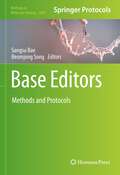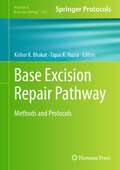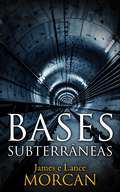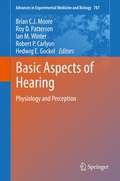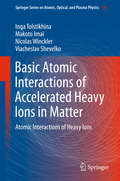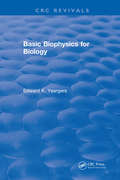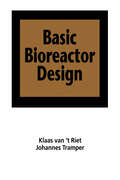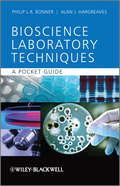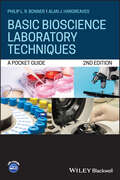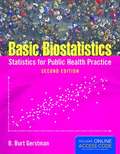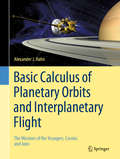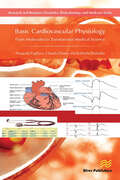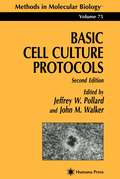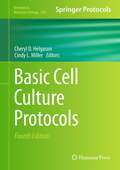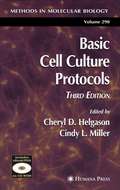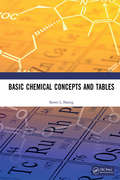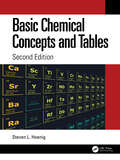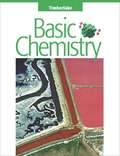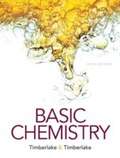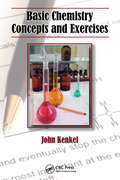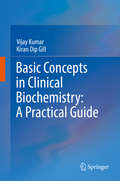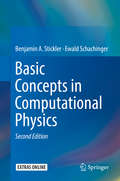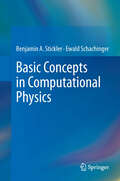- Table View
- List View
Base Editors: Methods and Protocols (Methods in Molecular Biology #2606)
by Sangsu Bae Beomjong SongThis volume explores base editors (BEs), an invaluable CRISPR-based genome editing tool with a wide variety of versatile applications. Beginning with an overview of BEs, their diverse variants, and computational tools, the book continues with experimental applications of BEs for disease modeling in mammalian cells and generating mutagenic mice, therapeutic base editing strategies, which covers delivery methods of BE-encoded DNA plasmids, mRNAs, or ribonucleoproteins through viruses or non-viral lipid nanoparticles, and lastly, the use of BEs in plants and bacteria. Written for the highly successful Methods in Molecular Biology series, chapters include introductions to their respective topics, lists of the necessary materials and reagents, step-by-step and readily reproducible laboratory protocols, and tips on troubleshooting and avoiding known pitfalls. Authoritative and practical, Base Editors: Methods and Protocols serves as an ideal guide for researchers looking to use base editors to continue their studies in an array of fields.
Base Excision Repair Pathway: Methods and Protocols (Methods in Molecular Biology #2701)
by Kishor K. Bhakat Tapas K. HazraThis detailed volume provides a comprehensive set of experimental protocols and useful strategies to examine the repair of damaged bases via the Base Excision Repair (BER) pathway in vitro and in cells. Beginning with multiple molecular and cellular techniques to examine the excision of damaged bases from double-stranded DNA or DNA wrapped in a nucleosome, the book continues with sections covering procedures to detect and quantify the damaged bases, protein DNA crosslinks, and double-strand breaks, experimental procedures to identify DNA repair protein interactome by conventional tandem affinity purification followed by mass spectroscopy analysis, as well as the analysis of genome-wide binding of DNA repair proteins and copy number variations of the DNA damage response gene in tumors. Written for the highly successful Methods in Molecular Biology series, chapters include introductions to their respective topics, lists of the necessary materials and reagents, step-by-step and readily reproducible laboratory protocols, and tips on troubleshooting and avoiding known pitfalls. Authoritative and practical, Base Excision Repair Pathway: Methods and Protocols serves as a valuable resource for novices and experts trying to examine the repair of various types of DNA lesions in vitro and in cell by the distinct set of proteins in the BER pathway.
Bases Subterrâneas
by James Morcan Lance Morcan Anabela SousaBases Subterrâneas revela detalhes sobre instalações subterrâneas nos Estados Unidos e ao redor do mundo, confirmadas e rumorejadas. Contendo raras provas fotográficas, bem como citações pouco conhecidas de figuras chave do governo, lança argumentos convincentes para a existência de um enorme mundo oculto sob a superfície da terra.
Basic Aspects of Hearing: Physiology and Perception (Advances in Experimental Medicine and Biology #787)
by Brian C. Moore Robert P. Carlyon Roy D. Patterson Ian M. Winter Hedwig E GockelThe International Symposium on Hearing is a highly-prestigious, triennial event where world-class scientists present and discuss the most recent advances in the field of hearing research in animals and humans. Presented papers range from basic to applied research, and are of interest neuroscientists, otolaryngologists, psychologists, and artificial intelligence researchers. Basic Aspects of Hearing: Physiology and Perception includes the best papers from the 2012 International Symposium on Hearing. Over 50 chapters focus on the relationship between auditory physiology, psychoacoustics, and computational modeling.
Basic Atomic Interactions of Accelerated Heavy Ions in Matter: Atomic Interactions Of Heavy Ions (Springer Series on Atomic, Optical, and Plasma Physics #98)
by Viacheslav Shevelko Inga Tolstikhina Makoto Imai Nicolas WincklerThis book provides an overview of the recent experimental and theoretical results on interactions of heavy ions with gaseous, solid and plasma targets from the perspective of atomic physics. The topics discussed comprise stopping power, multiple-electron loss and capture processes, equilibrium and non-equilibrium charge-state fractions in penetration of fast ion beams through matter including relativistic domain. It also addresses mean charge-states and equilibrium target thickness in ion-beam penetrations, isotope effects in low-energy electron capture, lifetimes of heavy ion beams, semi-empirical formulae for effective cross sections. The book is intended for researchers and graduate students working in atomic, plasma and accelerator physics.
Basic Biophysics for Biology
by Edward K. YeargersBasic Biophysics for Biology presents the fundamental physical and chemical principles required to understand much of modern biology. The author has made extensive use of illustrations rather than a mathematical approach to establish connections between macroscopic-world models and submicroscopic phenomena. Topics covered include the nucleus, atomic and molecular structure, the principles of thermodynamics, free energy, catalysis, diffusion, and heat flow. Students and professionals in general biology, physiology, genetics, and radiation biology will appreciate this carefully prepared, non-mathematical volume.
Basic Bioreactor Design
by Johannes Tramper Klaas van't RietBased on a graduate course in biochemical engineering, provides the basic knowledge needed for the efficient design of bioreactors and the relevant principles and data for practical process engineering, with an emphasis on enzyme reactors and aerated reactors for microorganisms. Includes exercises,
Basic Bioscience Laboratory Techniques
by Alan J. Hargreaves Philip L.R. BonnerThis unique, practical, pocket-sized guide and reference provides every first year bioscience student with all they need to know to prepare reagents correctly and perform fundamental laboratory techniques. It also helps them to analyse their data and present their findings, in addition to directing the reader, via a comprehensive list of references, to relevant further readingAll of the core bioscience laboratory techniques are covered including: basic calculations and the preparation of solutions; aseptic techniques; microscopy techniques; cell fractionation ; spectrophotometry; chromatography of small and large molecules: electrophoresis of proteins and nucleic acids and data analysis. In addition the book includes clear, relevant diagrams and worked examples of calculations.In short, this is a 'must-have' for all first year bioscience students struggling to get to grips with this vitally important element of their course.
Basic Bioscience Laboratory Techniques: A Pocket Guide
by Alan J. Hargreaves Philip L.R. BonnerA portable and pocket-sized guide to foundational bioscience and biomedical science laboratory skills The newly revised Second Edition of Basic Bioscience Laboratory Techniques: A Pocket Guide delivers a foundational and intuitive pocket reference text that contains essential information necessary to prepare reagents, perform fundamental laboratory techniques, and analyze and interpret data. This latest edition brings new updates to health and safety considerations, points of good practice, and explains the basics of molecular work in the lab. Perfect for first year undergraduate students expected to possess or develop practical laboratory skills, this reference is intended to be accessed quickly and regularly and inform the reader's lab techniques and methods. It assumes no prior practical knowledge and offers additional material that can be found online. The book also includes: A thorough introduction to the preparation of solutions in bioscience research Comprehensive explorations of microscopy and spectrophotometry and data presentation Practical discussions of the extraction and clarification of biological material, as well as electrophoresis of proteins and nucleic acids In-depth examinations of chromatography, immunoassays, and cell culture techniques Basic Bioscience Laboratory Techniques: A Pocket Guide is an indispensable reference for first year students at the BSc level, as well as year one HND/Foundation degree students. It's also a must-read resource for international masters' students with limited laboratory experience. In addition, it is a valuable aide-memoire to UG and PG students during their laboratory project module.
Basic Biostatistics: Statistics for Public Health Practice
by B. Burt GerstmanBasic Biostatistics is a concise, introductory text that covers biostatistical principles and focuses on the common types of data encountered in public health and biomedical fields. The text puts equal emphasis on exploratory and confirmatory statistical methods. Sampling, exploratory data analysis, estimation, hypothesis testing, and power and precision are covered through detailed, illustrative examples. The book is organized into three parts: Part I addresses basic concepts and techniques; Part II covers analytic techniques for quantitative response variables; and Part III covers techniques for categorical responses. The Second Edition offers many new exercises as well as an all new chapter on "Poisson Random Variables and the Analysis of Rates." With language, examples, and exercises that are accessible to students with modest mathematical backgrounds, this is the perfect introductory biostatistics text for undergraduates and graduates in various fields of public health. Features: Illustrative, relevant examples and exercises incorporated throughout the book. Answers to odd-numbered exercises provided in the back of the book. (Instructors may requests answers to even-numbered exercises from the publisher. Chapters are intentionally brief and limited in scope to allow for flexibility in the order of coverage. Equal attention is given to manual calculations as well as the use of statistical software
Basic Biotechnology
by Colin Ratledge Bjørn KristiansenBiotechnology is one of the major technologies of the twenty-first century. Its wide-ranging, multi-disciplinary activities include recombinant DNA techniques, cloning and the application of microbiology to the production of goods from bread to antibiotics. In this new edition of the textbook Basic Biotechnology, biology and bioprocessing topics are uniquely combined to provide a complete overview of biotechnology. The fundamental principles that underpin all biotechnology are explained and a full range of examples are discussed to show how these principles are applied; from starting substrate to final product. A distinctive feature of this text are the discussions of the public perception of biotechnology and the business of biotechnology, which set the science in a broader context. This comprehensive textbook is essential reading for all students of biotechnology and applied microbiology, and for researchers in biotechnology industries.
Basic Calculus of Planetary Orbits and Interplanetary Flight: The Missions of the Voyagers, Cassini, and Juno
by Alexander J. HahnIntended for a one- or two-semester course, this text applies basic, one-variable calculus to analyze the motion both of planets in their orbits as well as interplanetary spacecraft in their trajectories. The remarkable spacecraft missions to the inner and outermost reaches of our solar system have been one of the greatest success stories of modern human history. Much of the underlying mathematical story is presented alongside the astonishing images and extensive data that NASA’s Voyager, NEAR-Shoemaker, Cassini, and Juno missions have sent back to us. First and second year college students in mathematics, engineering, or science, and those seeking an enriching independent study, will experience the mathematical language and methods of single variable calculus within their application to relevant conceptual and strategic aspects of the navigation of a spacecraft. The reader is expected to have taken one or two semesters of the basic calculus of derivatives, integrals, and the role that limits play. Additional prerequisites include knowledge of coordinate plane geometry, basic trigonometry, functions and graphs, including trig, inverse, exponential, and log functions. The discussions begin with the rich history of humanity’s efforts to understand the universe from the Greeks, to Newton and the Scientific Revolution, to Hubble and galaxies, to NASA and the space missions. The calculus of polar functions that plays a central mathematical role is presented in a self-contained way in complete detail. Each of the six chapters is followed by an extensive problem set that deals with and also expands on the concerns of the chapter. The instructor has the flexibility to engage them with greater or lesser intensity. “I have been an aerospace engineer for 39 years and honestly, it would be hard for me to overstate how valuable I believe this book will be to numerous scientific and engineering disciplines and in particular to the future of aerospace engineering … This book is perfectly crafted to motivate, educate, and prepare the scientists and engineers who wish to reach for the sky and beyond.” —Dr. Mario Zoccoli, Aerospace Engineer, NASA and Lockheed Martin
Basic Cardiovascular Physiology: From Molecules to Translational Medical Science
by Pasquale Pagliaro Claudia Penna Raffaella RastaldoThis book focuses on established cardiovascular principles and highlights some of the progress achieved by recent research in the cardiovascular field. The authors report the basic concepts related to the functioning of the cardiovascular system necessary for medical students to understand. To foster learning, in each chapter the fundamental points are highlighted in italics and/or bold. In addition, we have added boxes that contain some more detailed information about physiological mechanisms or clinical aspects are analyzed and described in greater detail. The book describes the structure and function of the heart and vascular system for the reader to understand how the cardiovascular system responds in both health and disease. The book conveys a unified vision of the function of the heart and the vascular system, explaining the complexity of the system that goes far beyond the integrated connection between preload, afterload and cardiac contractility. The endothelium covers the internal part of the whole cardiovascular system; therefore, endothelial physiology is treated in several chapters. Given the importance of coronary circulation in cardiac pathophysiology, this special circulation is described in detail and enriched with the most up-to-date information. Several paragraphs and boxes on clinical implications are dedicated to the principles of electrophysiology and the electrocardiogram. A space is also dedicated to myocardial ischemia/reperfusion injury and cardioprotective procedures. The book is written in a linear and simple language without compromising the scientific rigor of the various topics covered.
Basic Cell Culture Protocols, 2nd edition: Second Edition (Methods in Molecular Biology #75)
by John M. Walker Jeffrey W. PollardNow completely revised and updated from the original, much-acclaimed and bestselling first edition, Basic Cell Culture Protocols, Second Edition offers today's most comprehensive collection of easy-to-follow, cutting-edge protocols for the culture of a wide range of animal cells. Its authoritative contributors provide explicit, step-by-step instructions, along with extensive notes and tips that allow both experts and beginners to successfully achieve their desired results. Topics range from basic culture methodology to strategies for culturing previously uncultured cell types and hard-to-culture differentiated cells. Methods are also provided for the analysis of living cells by FACS, video microscopy, and confocal microscopy. Like the first edition, this book should be in every cell culture laboratory and be of use to all who use cell cultures in research.
Basic Cell Culture Protocols, Fourth Edition (Methods in Molecular Biology #946)
by Cheryl D. Helgason Cindy L. MillerAt some point in their careers, virtually every scientist and technician, as well as many medical professionals, regardless of their area of specialization have a need to utilize cell culture systems. Updating and significantly expanding upon the previous editions, Basic Cell Culture Protocols, Fourth Edition provides the novice cell culturist with sufficient information to perform the basic techniques, to ensure the health and identity of their cell lines, and to be able to isolate and culture specialized primary cell types. The intent of this extensive volume is to generate a valuable resource containing clear methodologies pertinent to current areas of investigation, rather than attempting to educate cell culturists on specific cell types or organ systems. Written in the highly successful Methods in Molecular Biology™, chapters include introductions to their respective topics, lists of the necessary materials and reagents, step-by-step, readily reproducible laboratory protocols, and tips on troubleshooting and avoiding known pitfalls.<P><P> Comprehensive and up-to-date, Basic Cell Culture Protocols, Fourth Edition compiles the essential techniques needed to approach this vital laboratory activity with full success.
Basic Cell Culture Protocols, Third Edition (Methods in Molecular Biology #290)
by Cheryl D. Helgason Cindy L. MillerIn this fully revised edition of an established classic, expert researchers and clinicians describe in step-by-step detail updated techniques for the isolation and growth of the major primary cell types, such as kidney proximal tubule cells, hepatocytes, keratinocytes, and cardiomyocytes. The authors offer readily reproducible new methods for the differentiation of embryonic stem (ES) cells into various hematopoietic cell types, for fetal thymic organ culture, and for the isolation and culture of specialized cell types, such as mammary progenitor cells, skeletal muscle myofibers, mesenchymal cells, neural stem cells, hematopoietic cells, stromal cell lines, and endothelial cells. Additional chapters describe new techniques (leukocyte rolling, isolation of side population cells, and scalable production of ES-derived cells) and detail quality control methods for cell lines (detection and elimination of mycoplasma, DNA fingerprinting, and cytogenetic analysis). The protocols follow the successful Methods in Molecular Biology™ series format, each offering step-by-step laboratory instructions, an introduction outlining the principle behind the technique, lists of the necessary equipment and reagents, and tips on troubleshooting and avoiding known pitfalls.<P><P> Up-to-date and highly practical, Basic Cell Culture Protocols, Third Edition, offers basic scientists and clinician-researchers powerful tools to isolate, culture, and characterize the promising specialized cell types in demand today.
Basic Chemical Concepts and Tables
by Steven L. HoenigWritten as a quick reference to the many different concepts and ideas encountered in chemistry, Basic Chemical Concepts and Tables presents important subjects in a concise format that makes it a practical resource for any reader. The author covers multiple subjects including general chemistry, inorganic chemistry, organic chemistry, and spectral analysis. Separate chapters offer physical constants and unit measurements commonly encountered and mathematical concepts needed when reviewing or working with basic chemistry concepts. Other features include: Tables that are useful as for the interpretation of ultra-violet (UV), infra-red (IR), nuclear magnetic resonance (NMR) and mass spectroscopy (MS) spectra. Physical constants and unit measurements that are commonly encountered throughout the application of chemistry. Sections devoted to the concept of isomers and polymer structures. Graduate and undergraduate chemistry students, professionals, or instructors looking to refresh their understanding of a chemistry topic will find this ready reference indispensable in their daily work. Written as a quick reference to the many different concepts and ideas encountered in chemistry, Basic Chemical Concepts and Tables presents important subjects in a concise format that makes it a practical resource for any reader. The author covers multiple subjects including general chemistry, inorganic chemistry, organic chemistry, and spectral analysis. Separate chapters offer physical constants and unit measurements commonly encountered and mathematical concepts needed when reviewing or working with basic chemistry concepts. Other features include: Tables that are useful as for the interpretation of ultra-violet (UV), infra-red (IR), nuclear magnetic resonance (NMR) and mass spectroscopy (MS) spectra. Physical constants and unit measurements that are commonly encountered throughout the application of chemistry. Sections devoted to the concept of isomers and polymer structures. Graduate and undergraduate chemistry students, professionals, or instructors looking to refresh their understanding of a chemistry topic will find this ready reference indispensable in their daily work.
Basic Chemical Concepts and Tables
by Steven L. HoenigFully revised and expanded, the second edition of Basic Chemical Concepts and Tables is written as a quick reference to the many different concepts and ideas encountered in chemistry. The volume presents important subjects in a concise format that makes it a practical resource for any reader.Subjects include general chemistry, inorganic chemistry, organic chemistry, and spectral analysis. The new edition includes updated tables that are useful for the interpretation of ultraviolet-visible (UV-Vis), infrared (IR), nuclear magnetic resonance (NMR) and mass spectroscopy (MS) spectra, and expanded sections devoted to the concept of isomers and polymer structures and includes a new chapter on nuclear chemistry. Separate chapters offer physical constants and unit measurements commonly encountered and mathematical concepts needed when reviewing or working with basic chemistry concepts.Key features:• Provides chemical information in a concise format, fully illustrated with many graphs and charts, ideal for course review.• Supplements traditional exam review books, serving undergraduate or graduate students.• Provides professionals looking for a quick introduction to a topic with a comprehensive ready reference.Graduate and undergraduate chemistry students, professionals or instructors looking to refresh their understanding of a chemistry topic will find this reference indispensable in their daily work.
Basic Chemistry
by Karen C. TimberlakeIntended for allied health programs, this colorful textbook describes combinations of atoms in molecules, the interaction of atoms and molecules in chemical reactions, the rates of reactions, the properties of gases, solutions, acids and bases, and the characteristics of oxidation and reduction reactions. Real-life applications throughout the text illustrate the role of science and chemistry in the real world. Annotation ©2004 Book News, Inc., Portland, OR (booknews.com)
Basic Chemistry
by Karen C. Timberlake William TimberlakeFor courses in introductory, preparatory, and basic chemistry.
Basic Chemistry
by Karen and William TimberlakeBasic Chemistry gives you the problem-solving tools and techniques you'll need to succeed in future chemistry courses and in the work force. In a clear, friendly writing style, Timberlake continues to make chemistry relevant and engaging. Her unique “Guide to Problem-Solving” strategy provides a visual, step-by-step plan that helps to solve a wide variety of problems. Sample and practice problems throughout each chapter help you practice and master quantitative skills. Real-world applications cover modern, interesting topics in helping connect chemical principles to events in today's world, while interviews with engineers, doctors, veterinarians, and biochemists show the importance of chemistry in future careers.
Basic Chemistry Concepts and Exercises
by John KenkelChemistry can be a daunting subject for the uninitiated, and all too often, introductory textbooks do little to make students feel at ease with the complex subject matter. Basic Chemistry Concepts and Exercises brings the wisdom of John Kenkel's more than 35 years of teaching experience to communicate the fundamentals of chemistry in a practical, d
Basic Concepts in Clinical Biochemistry: A Practical Guide
by Vijay Kumar Kiran Dip GillThis book is a practical guidebook in biochemistry, for medical as well as life sciences' students. The book covers reference values, sample collection procedure and detailed protocol to perform experiments. Each experiment starts with a brief introduction of the protocol, followed by specimen requirements and procedure. The procedures are presented in a very lucid manner and discuss details of calculations and clinical interpretations,The book is divided into 29 chapters, It offers references, general guidelines and abbreviations and provides principles and procedures of clinical biochemistry tests, along with their diagnostic importance.
Basic Concepts in Computational Physics
by Benjamin A. Stickler Ewald SchachingerThis new edition is a concise introduction to the basic methods of computational physics. Readers will discover the benefits of numerical methods for solving complex mathematical problems and for the direct simulation of physical processes. The book is divided into two main parts: Deterministic methods and stochastic methods in computational physics. Based on concrete problems, the first part discusses numerical differentiation and integration, as well as the treatment of ordinary differential equations. This is extended by a brief introduction to the numerics of partial differential equations. The second part deals with the generation of random numbers, summarizes the basics of stochastics, and subsequently introduces Monte-Carlo (MC) methods. Specific emphasis is on MARKOV chain MC algorithms. The final two chapters discuss data analysis and stochastic optimization. All this is again motivated and augmented by applications from physics. In addition, the book offers a number of appendices to provide the reader with information on topics not discussed in the main text. Numerous problems with worked-out solutions, chapter introductions and summaries, together with a clear and application-oriented style support the reader. Ready to use C++ codes are provided online.
Basic Concepts in Computational Physics
by Ewald Schachinger Benjamin A. SticklerWith the development of ever more powerful computers a new branch of physics and engineering evolved over the last few decades: Computer Simulation or Computational Physics. It serves two main purposes:- Solution of complex mathematical problems such as, differential equations, minimization/optimization, or high-dimensional sums/integrals.- Direct simulation of physical processes, as for instance, molecular dynamics or Monte-Carlo simulation of physical/chemical/technical processes.Consequently, the book is divided into two main parts: Deterministic methods and stochastic methods. Based on concrete problems, the first part discusses numerical differentiation and integration, and the treatment of ordinary differential equations. This is augmented by notes on the numerics of partial differential equations. The second part discusses the generation of random numbers, summarizes the basics of stochastics which is then followed by the introduction of various Monte-Carlo (MC) methods. Specific emphasis is on MARKOV chain MC algorithms. All this is again augmented by numerous applications from physics. The final two chapters on Data Analysis and Stochastic Optimization share the two main topics as a common denominator. The book offers a number of appendices to provide the reader with more detailed information on various topics discussed in the main part. Nevertheless, the reader should be familiar with the most important concepts of statistics and probability theory albeit two appendices have been dedicated to provide a rudimentary discussion.
